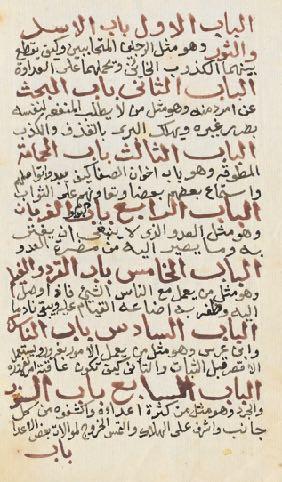A Copyist-Coauthor
Khouloud Khafallah
MS Wetzstein II 672 belongs to a group of manuscripts that once formed part of the library of the bibliophile and musical performer Aḥmad ar-Rabbāt from Aleppo, Syria. He assembled a large library, which is noteworthy for its rich selection of popular epics (siyar, sing. sīra), and which his sons turned into a lending library after his death. These codices contain copious notes made by borrowers who came from the less educated classes, including traders and artisans. Their writing shows that they were often barely literate, and it thereby documents the widening scope of readership during the early 19th century.
The manuscript’s title page runs: “This is the history of Kalīla and Dimna,” and it was copied by ar-Rabbāt himself in 1830 CE (1246 AH) a few years before his death (1836 or later). Together with other manuscripts, Wetzstein II 672 was acquired by the Prussian diplomat and orientalist named Johann Gottfried Wetzstein (1815-1905), who served as the Prussian consul in Damascus during the Ottoman Empire. Today it is held among the Oriental manuscripts of the Staatsbibliothek.
The text is divided into fourteen chapters (abwāb sing. bāb), comprising 131 folios. It is written in smaller black and a larger red nasḫ hand, the latter ink color being used for the chapter titles in the book, the table of contents (13v-14r, partially displayed above) and the colophon. Occasionally a larger black pen marks the beginning of a subtale (5r, 8r) of the inquit (qāla, 23r). The first folio (1v) is restored in another hand. The codex lacks illustrations but shows a number of marginal legends marking the insertion points and the description of illustrations (3r, 3v, 4r, etc.) without, however, leaving any space for the images themselves.
The version of the text contained in this copy shares certain passages with MS Paris Bibliothèque nationale de France arabe 3473, dated 1699 CE [1110 AH], and it resembles even more closely MS Riad 2407, held at King Faysal Library and copied by Mīḫaʾīl Naqqāš in 1691 CE (1103 AH), both of them preceding the Wetzstein copy by one and a half centuries.
The similarities among these three copies concern both form and content, including shared errors. In many places, however, the Wetzstein text is expanded with phrases that show influences of Levantine Arabic colloquial, and these were probably added by ar-Rabbāt himself. His additions are of interest, because they emphasize intellectual debate and learning and condemn ignorance. In particular in one substory about on a man who tried to learn classical Arabic by rote without understanding it, the added commentary chastises this man for missing a chance of true learning. This occurs in the preface of Ibn al-Muqaffaʿ, which is written in his first person, however the voice has merged with that of al-Rabbāṭ. The epistemological bent of the added phrases is noteworthy in the light of the fact that al-Rabbāt himself seemed to have been an autodidact and not part of the educated elite, and the language of his copy often departs from the ʿarabiyya.
His invasive engagement with the text (the details of which are still being investigated) may yield clues to the kind of audience among which Kalīla wa-Dimna circulated in the early 19th century, and which had visibly broadened to include strata of society beyond the educated elite.
